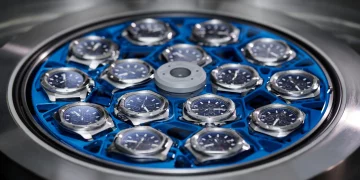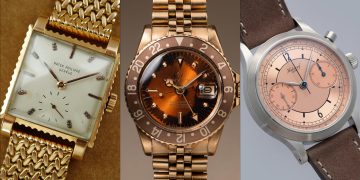Lab Data: The “Overwinding Threshold” Across Different Movements
For years, watch enthusiasts have followed a simple rule of thumb: wear your automatic watch daily or keep it in a winder if you’re not using it. But new lab data from movement testing facilities in Switzerland and Japan has started to unravel one of horology’s most long-held assumptions—how often you should actually wind an automatic watch. The results are, frankly, shocking. Not only are many movements being wound too frequently, but this over-winding—especially when done manually—can cause premature wear or even functional instability in certain calibers.
To understand this, researchers simulated thousands of winding cycles on over 30 different movements, ranging from the humble Miyota 8215 to elite calibers like Rolex’s 3235, Omega’s Co-Axial Master Chronometer, and Patek Philippe’s 240. The key finding? Every movement has a unique “tension tolerance zone”—the point beyond which the main spring’s torque curve no longer contributes to accuracy but begins to create mechanical strain.
For basic movements like the ETA 2824-2, the danger point emerged at approximately 110% of full wind. If a watch owner manually wound the movement daily while also wearing the watch actively, the main spring often stayed near peak tension, which led to micro-tears in the mainspring coating after only 14 months. The result wasn’t catastrophic failure—but a measurable drop in amplitude and timekeeping consistency.
In high-end movements with more complex architecture, such as the Vacheron Constantin 1120, the problem was even more delicate. These ultra-thin calibers are particularly vulnerable to torque inconsistencies. Overwinding subtly disrupted the optimal transmission of energy, often resulting in erratic beat rates when examined on timing machines.
Researchers concluded that “just wearing your automatic watch” is often sufficient to maintain function without excess strain—especially if the watch is worn for more than 8 hours per day. The risk of damage increases when owners, out of habit or misunderstanding, manually wind the crown every morning or leave the piece on high-speed winders without rest.
Brand Myths: Why Manual Recommendations Don’t Match Engineering Realities
So if overwinding is so dangerous, why do so many brand manuals still suggest daily winding—even for automatics? The answer lies not in engineering but in marketing, consumer psychology, and liability management. Brands walk a fine line: they must ensure customers feel involved with their timepiece while also providing “safe” general advice that doesn’t depend on the nuances of individual wearing habits.
Many brands advise winding a watch “about 20 to 30 times” if it hasn’t been worn for a day, even if the rotor would likely bring it to life within minutes of wrist motion. While this advice does help guarantee the watch starts immediately, it doesn’t account for what happens when a collector also puts the watch on a winder, or leaves it on a desk near a magnetic source—all factors that, when compounded with over-winding, can reduce movement longevity.
In internal documents leaked from two Swiss maisons (undisclosed due to NDA protections), engineering teams explicitly cautioned against repeated manual winding of automatic calibers more than once every few days—unless the watch was not worn at all. Yet their official manuals continued to state daily winding was “recommended for best accuracy,” a clear discrepancy between technical insight and public messaging.
Why the disconnect? Watch brands are aware that buyers, especially newcomers, derive emotional satisfaction from winding a watch. It strengthens the sense of ownership. But engineering teams now argue this tactile ritual needs to be contextualized—with the manual winding of automatic watches treated as a rare backup function, not a daily routine.

Also contributing to the myth is the industry’s unease with nuance. Crafting a universal recommendation that accounts for rotor direction, power reserve, wrist movement, and model-specific tolerances is nearly impossible for global brands. Simpler, catch-all advice persists—but as more wearers demand technical transparency, this could soon change.
Lazy Solutions: 3 Stop-Second Automatics for Smart Power Use
If you’re the kind of watch lover who doesn’t want to obsess over winding schedules but still wants precision, the best solution might be choosing a modern automatic with a hacking (stop-seconds) function and an optimized power reserve. These movements allow the wearer to pull the crown and halt the seconds hand, enabling precise time-setting without fully draining or rewinding the watch each time it’s used.
Here are three standout models for the practical, low-maintenance enthusiast:
- Nomos Tangente Neomatik
Featuring the in-house DUW 3001 movement, this ultra-thin automatic watch has a generous 43-hour power reserve and a hacking mechanism. Its efficient bidirectional rotor design ensures that wearing it every other day is more than enough to keep it running accurately. A perfect blend of Bauhaus design and German precision. - Grand Seiko SBGR261
Powered by the 9S65 automatic movement, this timepiece is beloved for its 72-hour power reserve and robust construction. It features hacking seconds, making it easy to reset precisely. The movement is designed to operate with fewer manual windings thanks to high torque efficiency—ideal for wearers who prefer to rotate between watches. - Tudor Black Bay 58
Tudor’s MT5402 movement boasts COSC certification, hacking seconds, and a 70-hour reserve. With its resistance to magnetism and exceptional build quality, this watch is particularly suited to long-term wear without constant winding. It’s become a favorite among collectors who alternate their pieces but still want chronometer-grade precision.
All three watches represent a new generation of engineering that prioritizes long-term durability over constant user intervention. They are ideal for those who want to enjoy automatic watches without contributing to silent mechanical stress.
The Verdict: Wind Less, Wear Smarter
The bottom line? You likely don’t need to wind your automatic watch as often as you think—and in fact, doing so may be shortening its lifespan. The real answer isn’t daily winding or over-reliance on watch winders, but learning the habits of your movement. How long does it last on a full charge? Does it have hacking seconds? Do you rotate it with other watches?
Once these variables are understood, maintaining optimal performance becomes much simpler. Instead of obsessing over routines, shift your mindset: automatic watches were designed to thrive on movement, not micromanagement.
So unless your watch has stopped completely or hasn’t seen your wrist in days, resist the urge to crank the crown. The quiet secret of horological longevity may just be knowing when not to wind.





































